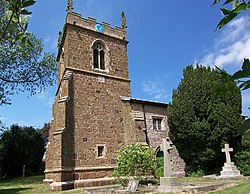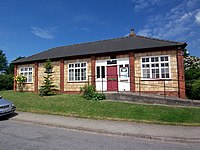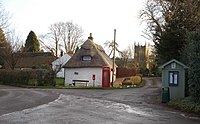South Willingham
| South Willingham | |
| Lincolnshire | |
|---|---|
 St Martin's Church, South Willingham | |
| Location | |
| Grid reference: | TF195833 |
| Location: | 53°20’0"N, 0°12’21"W |
| Data | |
| Population: | 160 (2011) |
| Post town: | Market Rasen |
| Postcode: | LN8 |
| Dialling code: | 01507 |
| Local Government | |
| Council: | East Lindsey |
| Parliamentary constituency: |
Louth and Horncastle |
South Willingham is a village in Lindsey, the northern part of Lincolnshire, and within the Lincolnshire Wolds. At South Willingham is Belmont Transmitting Station, the second tallest structure in the United Kingdom.
The name 'Willingham' is the Old English Willinga ham, meaning 'Willa's folk's homestead (or farm)'. South Willingham is recorded in the Domesday Book as "Ulingeham".
Contents
Parish church
The parish church, St Martin's, is built of greenstone. It was rebuilt between 1835 and 1838, but the Perpendicular Gothic-style tower and screen remain. It is Grade II* listed.[1]
The tower houses a clock and three bells, the largest of which is dated 1612; the clock mechanism was made by J W Benson of Ludgate Hill in London. The clock was repaired and refurbished in 2016,[2] and is still chiming the hours in 2019. In 1964, Pevsner noted a 1571 paten cover by John Morley.[3][4][5] The graveyard surrounds the church on three sides and has over 140 marked graves, the earliest of which is dated 1802.[6]
The parish is part of the 'Barkwith Group', which takes in the six surrounding churches and former ecclesiastical parishes of East Barkwith, West Barkwith, East Torrington, West Torrington, Sixhills, and Hainton.[7]
History and archaeology
Four bowl barrows at the east of the parish are evidence of early settlement; Bronze Age burial mounds dating from 2400-1500 BC, and aerial photographs show evidence of further barrows, now destroyed, north-east of Inns Farm. A Royal Observer Corps nuclear monitoring post was installed in the bowl barrow on the High Street, close to the junction with the Donington Road in 1959.[8] Officially known as the Burgh on Bain Post, it was used until 1991.[9]
In 1964 Beaker Pottery dating from about 1150-1400BC was found close to the sand pit at the end of Moors Lane.[10]
The Domesday Book records "Ulingeham" as containing three manors owned by different lords. The first had 11 villeins and two smallholders, with four ploughlands, 2.5 lord's and 2 men's plough teams, and a meadow of 77 acres. The lord in 1066 was Almer, but the lordship had passed after the Conquest to William of Verley, who controlled 10 manors in north-east Lincolnshire under the archbishop of York, Thomas of Bayeux, who became tenant-in-chief to the King. The second manor had four villeins and one smallholder, with 1.6 ploughlands, one lord's and one men's plough team, and a meadow of 36 acres. The lord in 1066 was Eskil, but n 1086 Wadard, a nobleman depicted in the Bayeux Tapestry, under Odo of Bayeux as tenant-in-chief to the King. The third had 13 freemen, 2.5 ploughlands, three men's plough teams and a meadow of 40 acres. The lord in 1066 was Koddi, but by 1086 was Gerard under Rainer of Brimeux as tenant-in-chief to the King.
There is aerial photographic evidence that the developed area of the village extended over the field to the north of Barkwith Road and to the west of Hainton Road.[11]
Before the 1870s Woodbine Cottage at the centre of the village served as the Post Office; from the 1870s the post office had transferred to a village shop opposite, which was run subsequently by the same family until it closed in the 1980s. There has never been a public house in the village. A pinfold is shown on the 1888 map at the edge of the village on Barkwith Road, where the village sign is currently located. It has gone on the 1906 map.
South Willingham had both a Wesleyan and a Free Methodist chapel,[12] built in 1834 and 1855 respectively. The Wesleyan chapel, on Barkwith Road and close to the centre of the village, closed in 1972.[13] The Free Methodist Chapel, sited further along Barkwith Road, closed in 1933; both are now converted to dwellings.
A school was built on Blacksmith Lane in 1834 for 30 children (the 1885 Kelly's Directory, the first to mention the school, says 40 children, but subsequent issues say 30). Average attendance was reported as 16 children in 1885, 22 in 1889, 18 in 1909 and 13 in 1913. It closed in 1918.[12][14][15][16] The remaining children transferred to the school in Hainton, the South Willingham building since converted to a residence.
A tower windmill was sited to the north-east of Mill Cottages on the Barkwith Road. The corn mill was built around the 1850s and fitted with six sails by Saundersons of Louth, but converted to four sails in the 1890s. The sails were removed in 1935[17] and the tower was demolished in 1958.[18] A mediæval windmill stood on the southern parish boundary, to the west of the Benniworth Road: the mound for this mill was discovered using aerial photographs.[19]
Much of the village formed part of the Heneage Estate; Hainton Hall is a mile north of the village. The woodwork of the estate buildings were painted a distinctive Post Office red. Most of the remaining land was owned by the Church, with Glebe Farm (now called Grange Farm) providing for the upkeep of the Church and the living that supported the Rector. Land to the east of the High Street forms part of the Stenigot Estate.
In 1957 the Heneage Estate auctioned off 34 dwellings and smallholdings [over half the village] in South Willingham and further property in surrounding villages.[20][21]
Culture and community
South Willingham Parish Hall was a gift to the village in 1922 from Lord Heneage. It is used for social and public events, meetings, coffee mornings, film nights, community groups;[22] during the summer it is used as a refreshment stop for cyclists; and as a meeting place for the parish council.
The village has a newsletter, distributed quarterly.
About the village
The parish has six Grade II and one Grade II* listed buildings, which include the church, two thatched cottages in the village centre, two other cottages and two farm houses.
The Belmont Transmitting Station is sited close to the High Street. At 1,154 feet in height, it is the tallest structure in the United Kingdom after the Skelton Mast (1,198 feet) in Cumberland. It was raised in 1965 and broadcasts digital television and both analogue and digital radio to Lincolnshire, eastern Yorkshire, northern parts of Norfolk and some parts of Nottinghamshire.
See also
Outside links
| ("Wikimedia Commons" has material about South Willingham) |
References
- ↑ National Heritage List 1359955: Church of St Martin (Grade II* listing)
- ↑ Church Clock reinstallation - YouTube
- ↑ St Martin's: The Parish of South Willingham - The Life & History of South Willingham (South Willingham History Group)
- ↑ Cox, J. Charles Lincolnshire (Methuen & Co, 1916) p. 334
- ↑ Nikolaus Pevsner: The Buildings of England: Lincolnshire, 1964; 1989 Penguin Books ISBN 978-0-300-09620-0
- ↑ "Monumental Inscriptions St Martin's Church", The Parish of South Willingham - The Life & History of South Willingham, South Willingham History Group. Retrieved 16 November 2019
- ↑ "Barkwith Group celebration", Horncastle News, 19 May 2016
- ↑ National Heritage List 1013924: Bowl barrow SSE of South Walk Farm (Scheduled ancient monument entry)
- ↑ Burgh on Bain post Subterranea Britannica
- ↑ "Just Who Were The First People To Settle In South Willingham?", The Parish of South Willingham - The Life & History of South Willingham, South Willingham History Group
- ↑ Soil Marks, South Willingham, Cambridge air photos, University of Cambridge
- ↑ 12.0 12.1 Kelly's Directory of Lincolnshire with the port of Hull 1885, p.708
- ↑ "South Willingham Chapels", The Parish of South Willingham - The Life & History of South Willingham, South Willingham History Group website. Retrieved 28 November 2019
- ↑ Kelly's Directory of Lincolnshire 1909, p.615
- ↑ Kelly's Directory of Lincolnshire 1919, p.601
- ↑ Kelly's Directory of Lincolnshire 1913, p.633
- ↑ "Tower mill, South Willingham" Dated pictures with and without sails in Mills Archive. Retrieved 22 November 2019
- ↑ "South Willingham, Windmill" in Photographic Galleries, Society for Lincolnshire History & Archaeology. Retrieved 20 November 2019
- ↑ Mediæval windmill mound south-east of South Willingham: Lincs to the Past
- ↑ "Selling off the Village" The Parish of South Willingham - The Life & History of South Willingham, South Willingham History Group website. Retrieved 19 November 2019
- ↑ "Particulars, plans and conditions of sale of outlying portions of the Hainton Estate", The Parish of South Willingham - The Life & History of South Willingham, South Willingham History Group website. Retrieved 19 November 2019
- ↑ Parish Hall: South Willingham History Group

